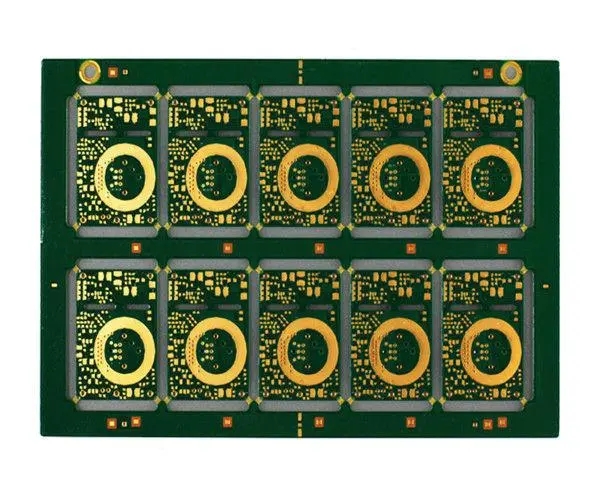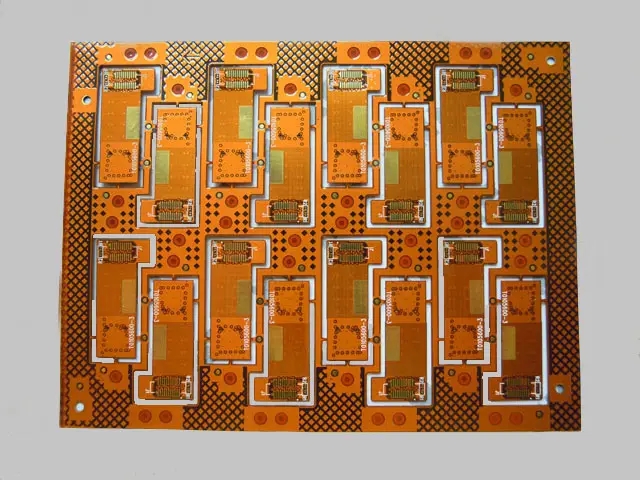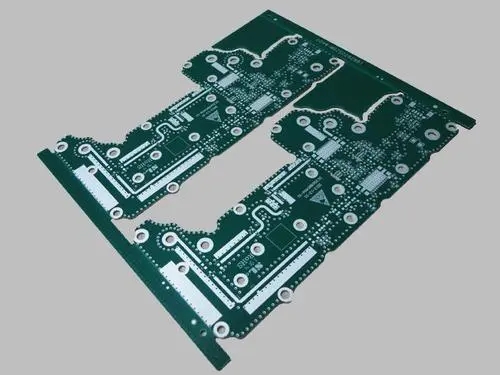
Introduction to final coating types on PCB board surface
PCB manufacturing, PCB design and PCBA processing manufacturers will explain the final coating types on PCB surface
The final coating process for PCB manufacturing has undergone significant changes in recent years. These changes are the result of the continuous demand to overcome the limitations of HASL (hot air solver level) and the increasing number of HASL alternatives.
The final coating is used to protect the surface of the circuit copper foil. Copper (Cu) is a good surface for welding components, but it is easy to be oxidized; Copper oxide hinders soldering. Although gold (Au) is now used to cover copper, because gold does not oxidize; Gold and copper will rapidly diffuse and infiltrate each other. Any exposed copper will quickly form a non weldable copper oxide. One method is to use a "barrier layer" of nickel (Ni), which prevents the transfer of gold and copper and provides a durable, conductive surface for component assembly.
PCB requirements for non electrolytic nickel coating, the non electrolytic nickel coating should complete several functions:
Surface of gold precipitation
The ultimate goal of the circuit is to form a connection with high physical strength and good electrical characteristics between PCB and components. If there is any oxide or contamination on the PCB surface, the current weak flux used for this welding connection will not occur.
Gold naturally precipitates on nickel and will not be oxidized during long-term storage. However, gold will not precipitate on oxidized nickel, so nickel must be kept pure between nickel bath and gold dissolution. In this way, the first requirement of nickel is to keep it free of oxidation for a long enough time to allow the precipitation of gold. The element has developed a chemical bath to allow 6-10% phosphorus content in nickel precipitation. This phosphorus content in the non electrolytic nickel coating is considered as a careful balance between bath control, oxides, and electrical and physical properties.
hardness
Non electrolytic nickel coatings are used in many applications requiring physical strength, such as automotive transmission bearings. The need for PCB is far less stringent than these applications, but for wire bonding, touch pad contact points, edge connectors, and processing sustainability, a certain hardness is important.
Lead wire bonding requires a nickel hardness. If the lead deforms the sediment, loss of friction may occur, which helps the lead "melt" into the substrate. SEM photos show no penetration into the surface of flat nickel/gold or nickel/palladium (Pd)/gold.
Electrical characteristics
Because it is easy to make, copper is chosen as the metal for circuit formation. The conductivity of copper is superior to almost every metal (Table 1) 1,2. Gold also has good conductivity and is the perfect choice for the outermost metal, because electrons tend to flow on the surface of a conductive path ("surface" benefits).
Table I Resistivity of PCB Metal
Copper 1.7 µ Ω cm
Gold 2.4 µ Ω cm
Nickel 7.4 µ Ω cm
Non electrolytic nickel coating 55~90 µ Ω cm
Although the electrical characteristics of most production boards are not affected by the nickel layer, nickel can affect the electrical characteristics of high-frequency signals. The signal loss of microwave PCB can exceed the designer's specifications. This phenomenon is proportional to the thickness of the nickel - the circuit needs to pass through the nickel to reach the solder joint. In many applications, electrical signals can be restored to design specifications by specifying nickel deposits of less than 2.5 µ m.
contact resistance
Contact resistance is different from solderability because nickel/gold surfaces remain solderless throughout the life of the end product. Nickel/gold must maintain the conductivity of external contact after long-term environmental exposure. Antler's 1970 work expressed the contact requirements of nickel/gold surfaces in terms of quantity. Various final use environments were studied: 3 "65 ° C, a normal maximum temperature of the electronic system working at room temperature, such as a computer; 125 ° C, the temperature at which universal connectors must work, which is often specified for military applications; 200 ° C, which is becoming increasingly important for flight equipment."
Nickel barriers are not required for low temperature environments. With the increase of temperature, the amount of nickel required to prevent nickel/gold transfer increases (Table 2).
Table II. Nickel/gold contact resistance (1000 hour result)
Satisfactory contact of nickel barrier layer at 65 ° C Satisfactory contact at 125 ° C Satisfactory contact at 200 ° C
0.0 µm 100% 40% 0%
0.5 µm 100% 90% 5%
2.0 µm 100% 100% 10%
4.0 µm 100% 100% 60%
The nickel used in Antler's study was electroplated. It is expected that improvements will be made from non electrolytic nickel, as confirmed by Baudrand. However, these results are for 0.5 µ m gold, where the plane usually precipitates 0.2 µ m. The plane can infer that it is sufficient for contact elements operating at 125 ° C, but higher temperature elements will require special testing.
Antler suggested: "The thicker the nickel, the better the barrier, which is true in all cases, but the actual situation of PCB manufacturing encourages engineers to only precipitate the amount of nickel required. Planar nickel/gold has now been used for cellular phones and pagers that use touch pad contact points. The specification of such components is at least 2 µ m nickel.
Connector
Non electrolytic nickel/gold dipping is used in the production of circuit boards containing spring fit, press fit, low voltage slip fit and other solderless connectors.
Plug in connectors require longer physical durability. In these cases, the strength of the non electrolytic nickel coating is sufficient for PCB applications, but the gold immersion is not enough. Very thin pure gold (60-90 Knoop) will be worn off from nickel when repeatedly rubbed. When the gold is removed, the exposed nickel oxidizes quickly, increasing the contact resistance.

Non electrolytic nickel coating/gold dipping may not be the best choice for plug-in connectors that experience multiple insertions throughout the life of the product. Nickel/palladium/gold surfaces are recommended for multipurpose connectors.
Barrier layer
Non electrolytic nickel has three barrier layers on the board: 1) prevent the diffusion of copper to gold; 2) Prevent the diffusion of gold to nickel; 3) The source of nickel formed by Ni3Sn4 intermetallic compound.
Diffusion of copper to nickel
The transfer of copper through nickel results in the decomposition of copper to surface gold. Copper will oxidize quickly, resulting in poor solderability during assembly, which occurs in the case of missing nickel plating. Nickel is required to prevent migration and diffusion during storage and transportation of empty plates and during assembly when other areas of plates have been welded. Therefore, the temperature requirement of the barrier layer is less than 250 ° C for less than one minute.
Turn and Owen6 have studied the effects of different barrier layers on copper and gold. They found that "... the comparison of copper permeability values at 400 ° C and 550 ° C shows that hexavalent chromium and nickel with 8-10% phosphorus content are the most effective barrier layers studied". (Table 3)
Table 3 Copper Penetrating through Nickel to Gold
Nickel thickness 400 ° C 24 hours 400 ° C 53 hours 550 ° C 12 hours
0.25 µm 1 µm 12 µm 18 µm
0.50 µm 1 µm 6 µm 15 µm
1.00 µm 1 µm 1 µm 8 µm
2.00 µ m Non diffusion Non diffusion Non diffusion
According to Arrhenius equation, the diffusion at lower temperature is exponentially slow. Interestingly, in this test, the efficiency of non electrolytic nickel is 2~10 times higher than that of electroplated nickel. Turn and Owen pointed out that "... a 2 µ m (80 µ inch) barrier (8%) of this alloy reduces copper diffusion to a negligible level."
From this extreme temperature test, it can be seen that the nickel thickness of at least 2 µ m is a safe specification.
Diffusion of nickel to gold
The second requirement of non electrolytic nickel is that nickel should not migrate through the "particles" or "pores" of gold leaching. If nickel comes into contact with air, it will oxidize. Nickel oxide is not solderable and difficult to remove with flux.
There are several articles about the use of nickel and gold in ceramic chip carriers. These materials are subjected to extreme temperatures of assembly for a long time. A common test for these surfaces is at 500 ° C for 15 minutes.
In order to evaluate the ability of planar non electrolytic nickel/gold dipping surface to prevent nickel oxidation, the solderability of temperature aging surface was studied. Different heat/humidity and time conditions were tested. These studies have shown that nickel is fully protected by gold immersion, allowing good solderability after long aging.
The diffusion of nickel to gold may be a limiting factor for assembly in some cases, such as gold thermoacoustic wire bonding. In this application, the nickel/gold surface is inferior to the nickel/palladium/gold surface. Iacovangelo studied the diffusion characteristics of palladium as a barrier layer between nickel and gold, and found that 0.5 µ m palladium can prevent migration even at extreme temperatures. This study also proves that there is no copper diffusion through 2.5 µ m nickel/palladium determined by Auger spectroscopy within 15 minutes at 500 ° C.
Nickel tin intermetallic compound
During surface mounting or wave soldering operation, atoms from the PCB surface will be mixed with solder atoms, depending on the diffusion characteristics of the metal and the ability to form "intermetallic compounds" (Table 4).
Table IV Diffusivity of PCB Materials in Welding
Diffusivity at metal temperature ° C (µ inches/sec.)
Jin 450 486 117.9 167.5
Copper 450 525 4.1 7.0
Palladium 450 525 1.4 6.2
Nickel 700 1.7
In the nickel/gold and tin/lead systems, the gold horse is dissolved in loose tin. Solder tin forms strong adhesion to the nickel below by forming Ni3Sn4 intermetallic compound. Sufficient nickel should be deposited to ensure that solder will not reach under copper. Bader's measurement shows that more than 0.5 µ m nickel is not needed to maintain this barrier layer, and even more than six temperature cycles are required. In fact, the maximum observed intermetallic layer thickness is less than 0.5 µ m (20 µ inch).
porosity
Non electrolytic nickel/gold has only recently become a common final PCB surface coating, so industrial processes may not be suitable for this surface. There is now a nitric acid vapor process for testing the porosity of electrolytic nickel/gold used as plug-in connectors (IPC-TM-650 2.3.24.2) 9. Non electrolytic nickel/gold leaching failed this test. A European porosity standard using potassium ferricyanide has been developed to determine the relative porosity of a plane surface. The results are given in terms of the number of small holes per square millimeter (points/mm2). A good flat surface should have less than 10 holes per square millimeter at 100 times the magnification factor.
conclusion
The PCB manufacturing industry is interested in reducing the amount of nickel deposited on circuit boards due to cost, cycle time and material compatibility. The minimum nickel specification should help prevent the diffusion of copper to gold surface, maintain good welding point strength, and lower contact resistance. The maximum nickel specification should allow flexibility in plate manufacturing, as no severe failure mode is associated with thick nickel deposits.
For most circuit board designs today, a non electrolytic nickel coating of 2.0 µ m (80 µ inches) is the minimum nickel thickness required. In practice, a range of nickel thicknesses will be used in one production lot number of PCB. The change in nickel thickness will be the result of the change in the characteristics of the soaking chemicals and the change in the dwell time of the automatic lifting machine. To ensure the minimum value of 2.0 µ m, the specifications from the end user should be 3.5 µ m, with a minimum of 2.0 µ m and a maximum of 8.0 µ m.
The specified range of nickel thickness has been proved to be suitable for the production of millions of circuit boards. This range meets the requirements for solderability, shelf life and contact with today's electronic products. Because assembly requirements differ from one product to another, the surface coating may need to be optimized for each particular application. PCB manufacturers, PCB designers and PCBA processors will introduce the final coating types on PCB surfaces.







